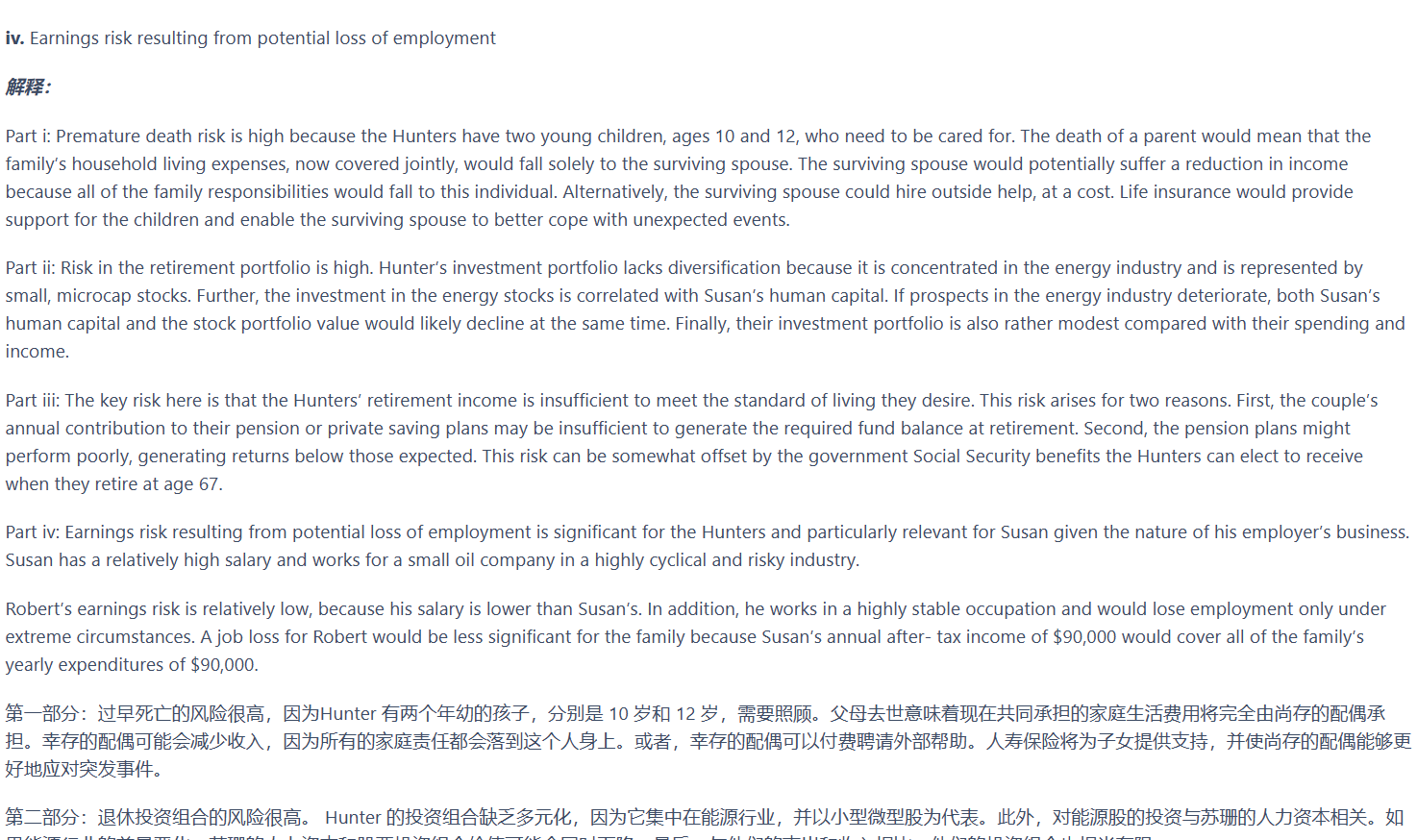NO.PZ202201040100000201
问题如下:
Susan and Robert Hunter, both age 47, live in the United States with their two children, ages 10 and 12. The Hunters both plan to retire at age 67. Susan works as a petroleum engineer at a small oil company, and Robert is a nurse at a local state-owned hospi- tal. The Hunters are saving for retirement and for their children’s college education expenses. Susan’s annual salary is $135,000 ($90,000 after taxes), and Robert’s annual salary is $55,000 ($36,000 after taxes). Their annual household living expenses are $90,000.
The Hunters have $50,000 in their bank account. They also have a stock portfolio consisting of five microcap energy stocks worth around $150,000, which they plan to use to partially fund their retirement needs. The Hunters plan to meet their retirement needs through contributions to pension plans offered by their employers, supplemented by government Social Security income payments starting at age 67. Both contribute 5% of their salaries to their respective defined contribution (DC) plans, but only Susan’s company offers a matching contribution up to 10% of her base salary. Susan’s DC plan has a current value of $80,000, while Robert’s plan has a current value of $40,000. Income and capital gain distributions within the plan are tax free.
The Hunters meet with Helen Chapman seeking financial advice. After reviewing the Hunters’ financial objectives, which include funding their retirement and the college education for their two children, Chapman discusses several risks facing the Hunters in their efforts to achieve those objectives.
Evaluate each of the following risks facing the Hunters:
i. Premature death risk
ii. Investment portfolio risk
iii. Risk to their retirement lifestyle goals
iv. Earnings risk resulting from potential loss of employment
解释:
Part i: Premature death risk is high because the Hunters have two young children, ages 10 and 12, who need to be cared for. The death of a parent would mean that the family’s household living expenses, now covered jointly, would fall solely to the surviving spouse. The surviving spouse would potentially suffer a reduction in income because all of the family responsibilities would fall to this individual. Alternatively, the surviving spouse could hire outside help, at a cost. Life insurance would provide support for the children and enable the surviving spouse to better cope with unexpected events.
Part ii: Risk in the retirement portfolio is high. Hunter’s investment portfolio lacks diversification because it is concentrated in the energy industry and is represented by small, microcap stocks. Further, the investment in the energy stocks is correlated with Susan’s human capital. If prospects in the energy industry deteriorate, both Susan’s human capital and the stock portfolio value would likely decline at the same time. Finally, their investment portfolio is also rather modest compared with their spending and income.
Part iii: The key risk here is that the Hunters’ retirement income is insufficient to meet the standard of living they desire. This risk arises for two reasons. First, the couple’s annual contribution to their pension or private saving plans may be insufficient to generate the required fund balance at retirement. Second, the pension plans might perform poorly, generating returns below those expected. This risk can be somewhat offset by the government Social Security benefits the Hunters can elect to receive when they retire at age 67.
Part iv: Earnings risk resulting from potential loss of employment is significant for the Hunters and particularly relevant for Susan given the nature of his employer’s business. Susan has a relatively high salary and works for a small oil company in a highly cyclical and risky industry.
Robert’s earnings risk is relatively low, because his salary is lower than Susan’s. In addition, he works in a highly stable occupation and would lose employment only under extreme circumstances. A job loss for Robert would be less significant for the family because Susan’s annual after- tax income of $90,000 would cover all of the family’s yearly expenditures of $90,000.
第一部分:过早死亡的风险很高,因为Hunter 有两个年幼的孩子,分别是 10 岁和 12 岁,需要照顾。父母去世意味着现在共同承担的家庭生活费用将完全由尚存的配偶承担。幸存的配偶可能会减少收入,因为所有的家庭责任都会落到这个人身上。或者,幸存的配偶可以付费聘请外部帮助。人寿保险将为子女提供支持,并使尚存的配偶能够更好地应对突发事件。
第二部分:退休投资组合的风险很高。 Hunter 的投资组合缺乏多元化,因为它集中在能源行业,并以小型微型股为代表。此外,对能源股的投资与苏珊的人力资本相关。如果能源行业的前景恶化,苏珊的人力资本和股票投资组合价值可能会同时下降。最后,与他们的支出和收入相比,他们的投资组合也相当有限。
第三部分:这里的主要风险是Hunter 的退休收入不足以满足他们想要的生活水平。这种风险的产生有两个原因。首先,这对夫妇对养老金或私人储蓄计划的年度供款可能不足以在退休时产生所需的资金余额。其次,养老金计划可能表现不佳,产生的回报低于预期。这种风险可以通过Hunter 在 67 岁退休时可以选择领取的政府社会保障福利来抵消。
第 四部分:由于潜在失业而导致的收入风险对 Hunters 来说意义重大,鉴于其雇主的业务性质,对 Susan 尤其相关。苏珊的薪水相对较高,在一家小型石油公司工作,处于高周期性和高风险行业。
罗伯特的收入风险相对较低,因为他的薪水低于苏珊。此外,他从事的职业非常稳定,只有在极端情况下才会失业。罗伯特失去工作对家庭来说意义不大,因为苏珊每年 90,000 美元的税后收入将支付全家每年 90,000 美元的支出。
只能通过提问看答案,





